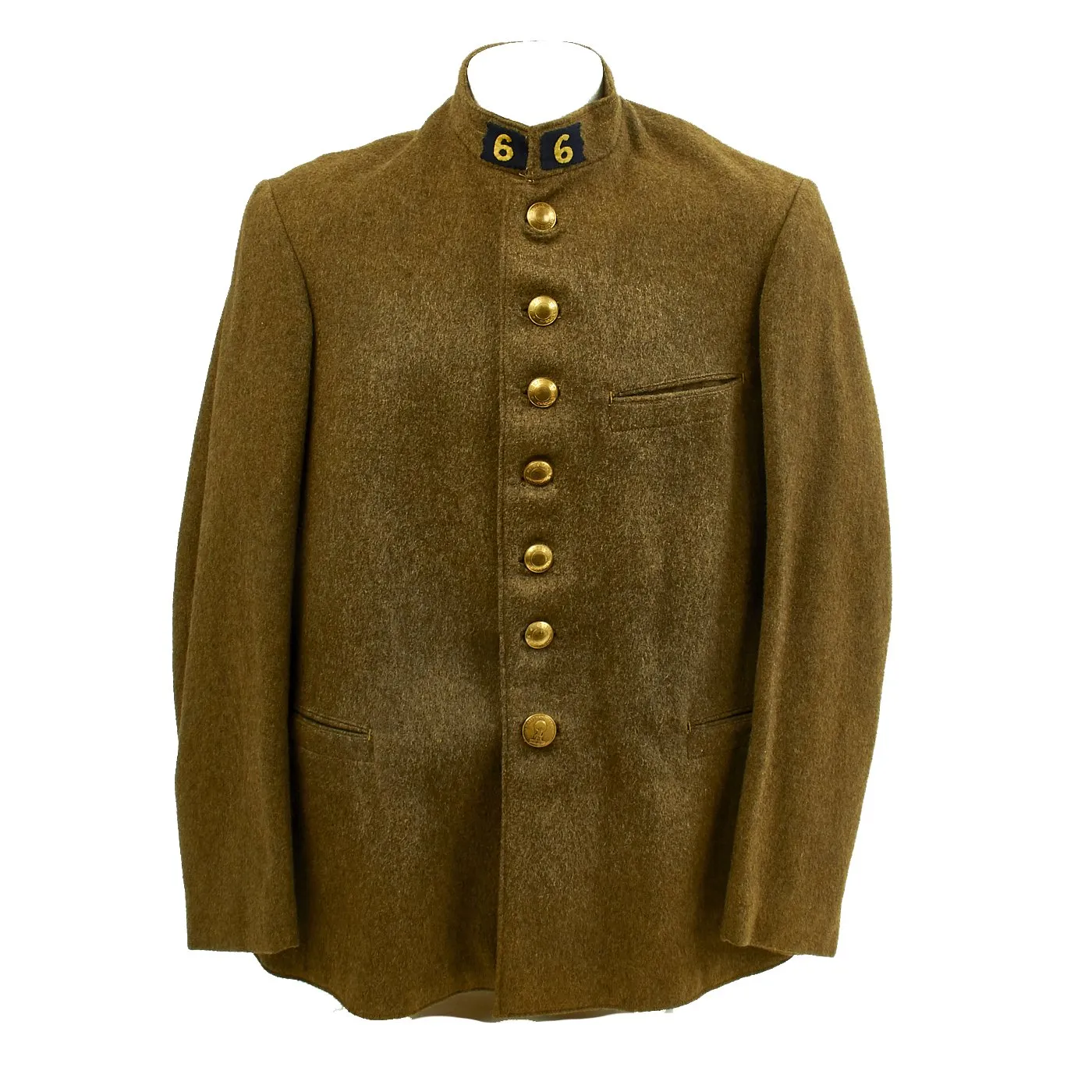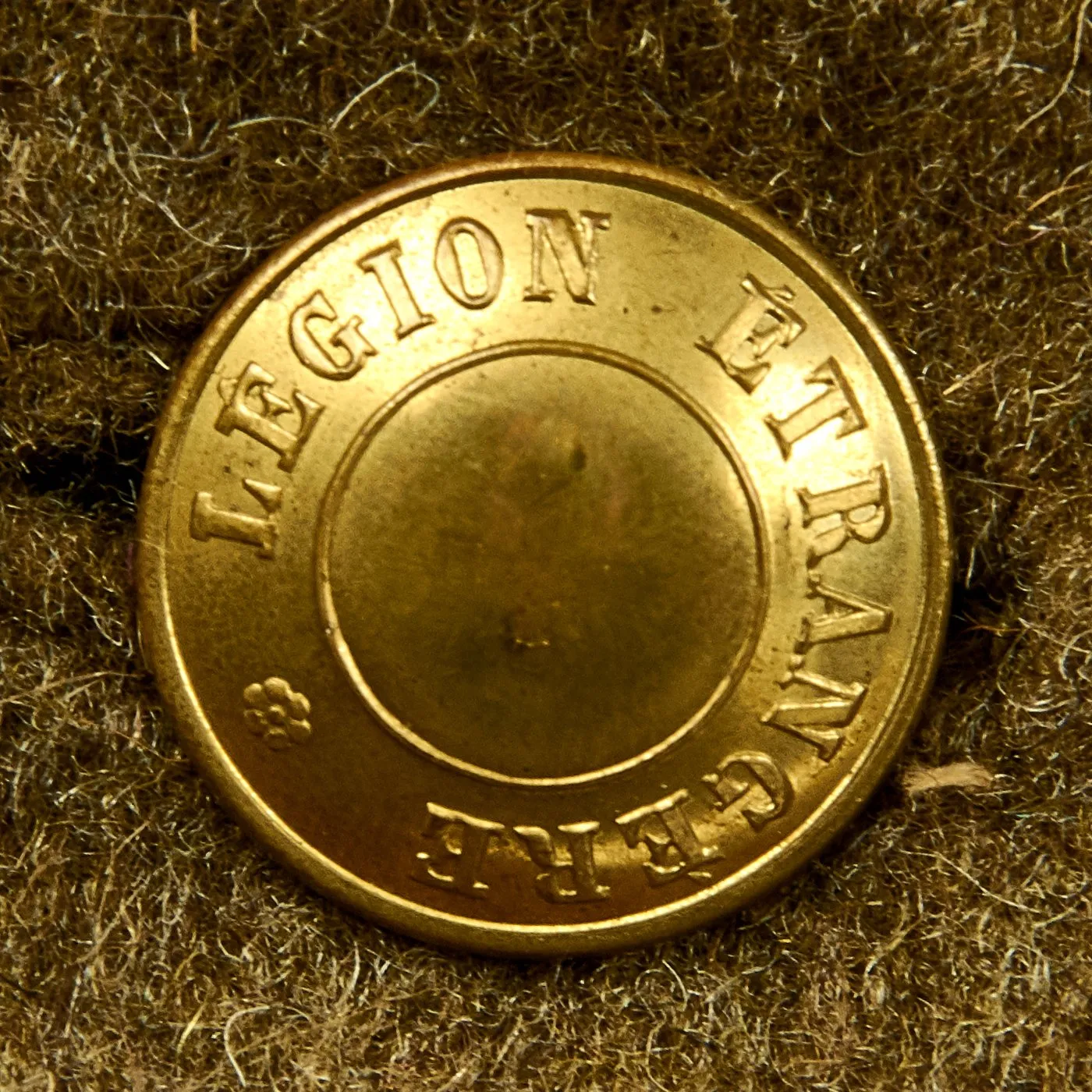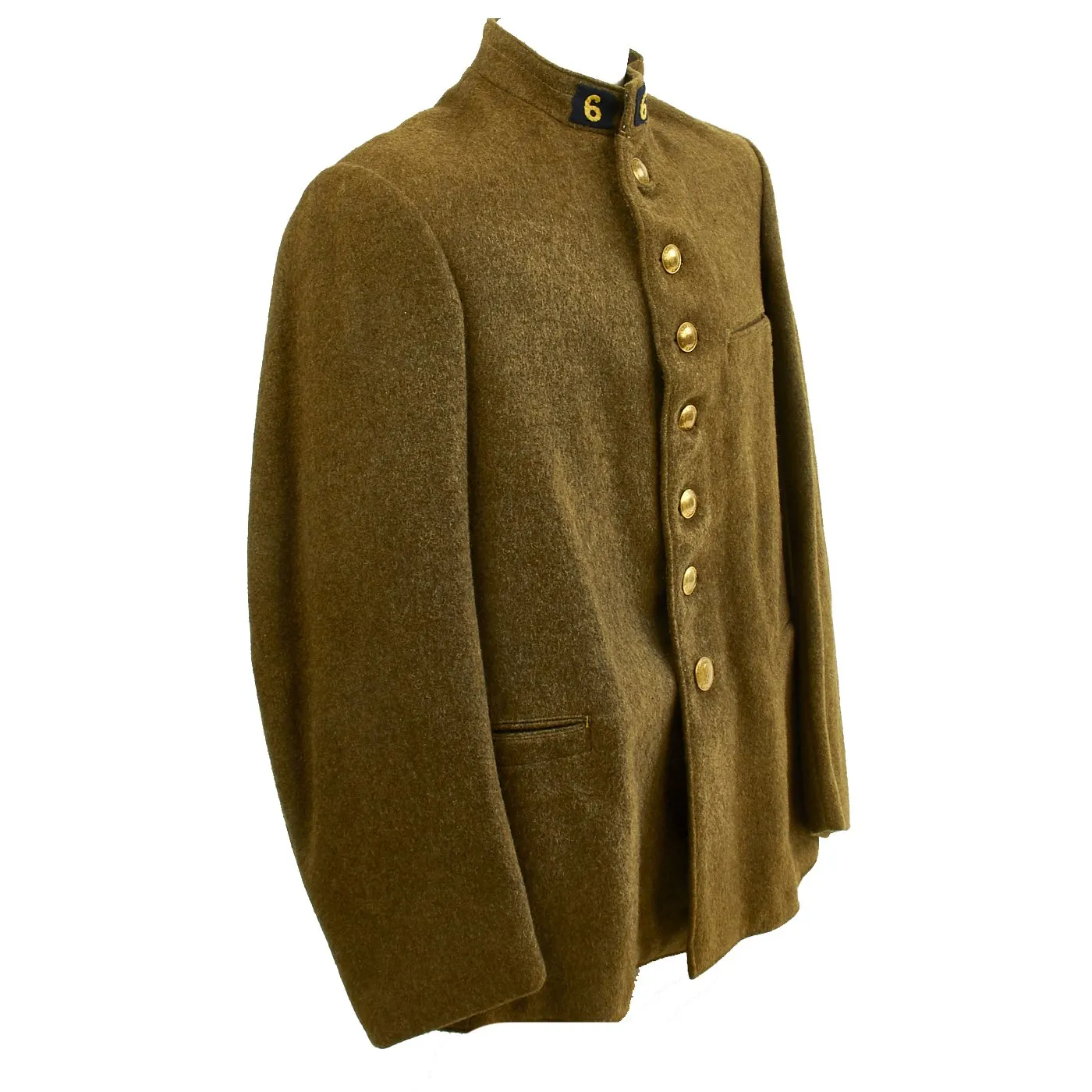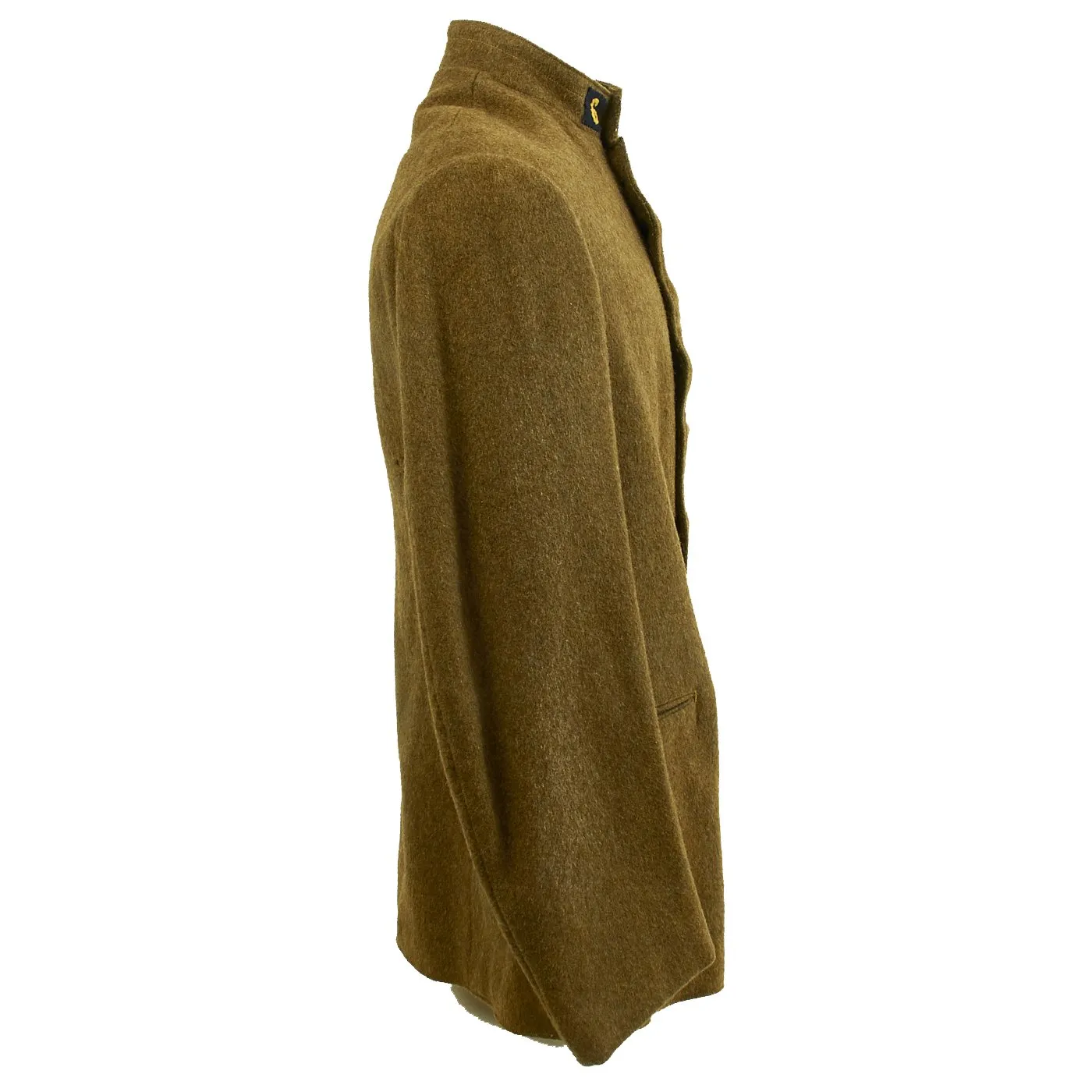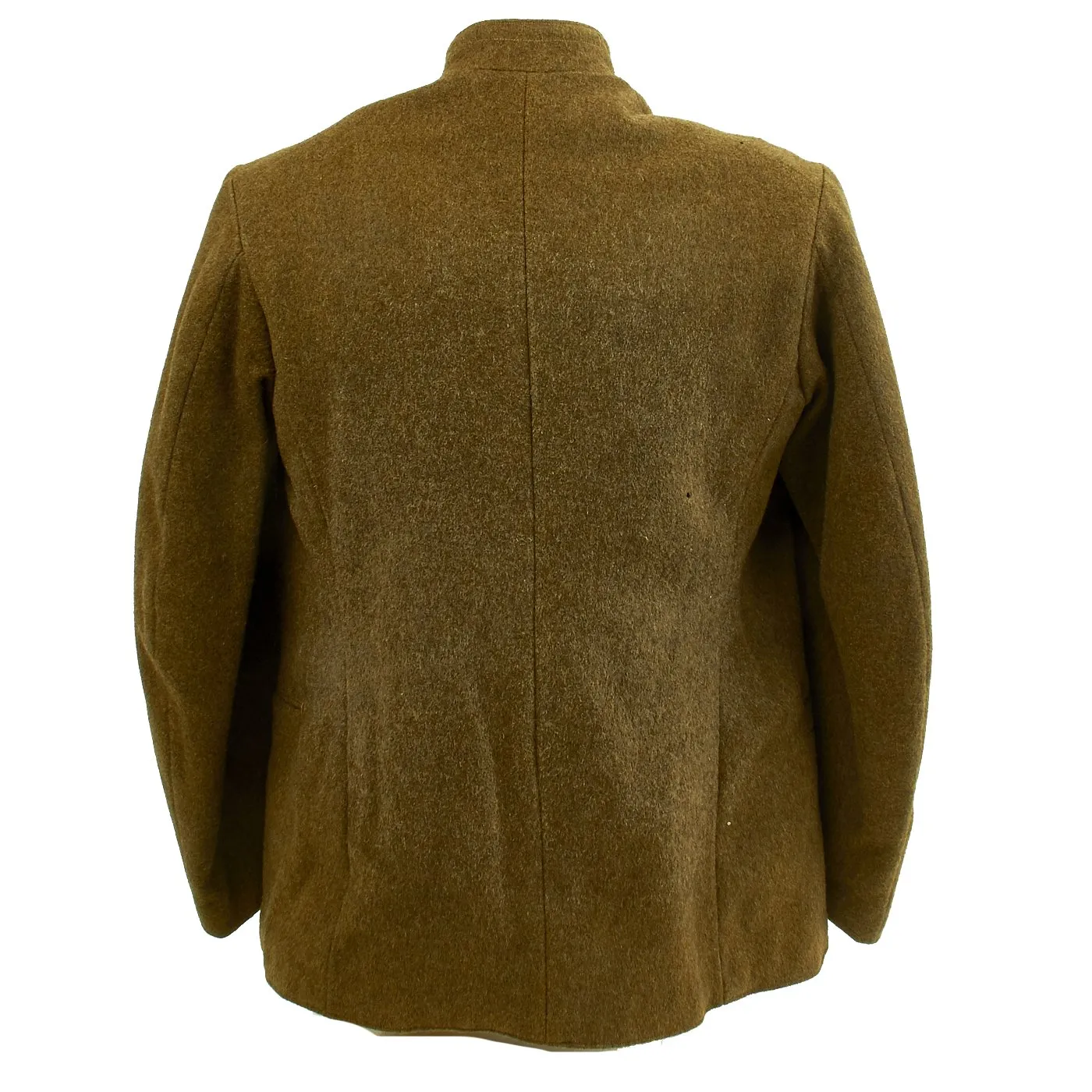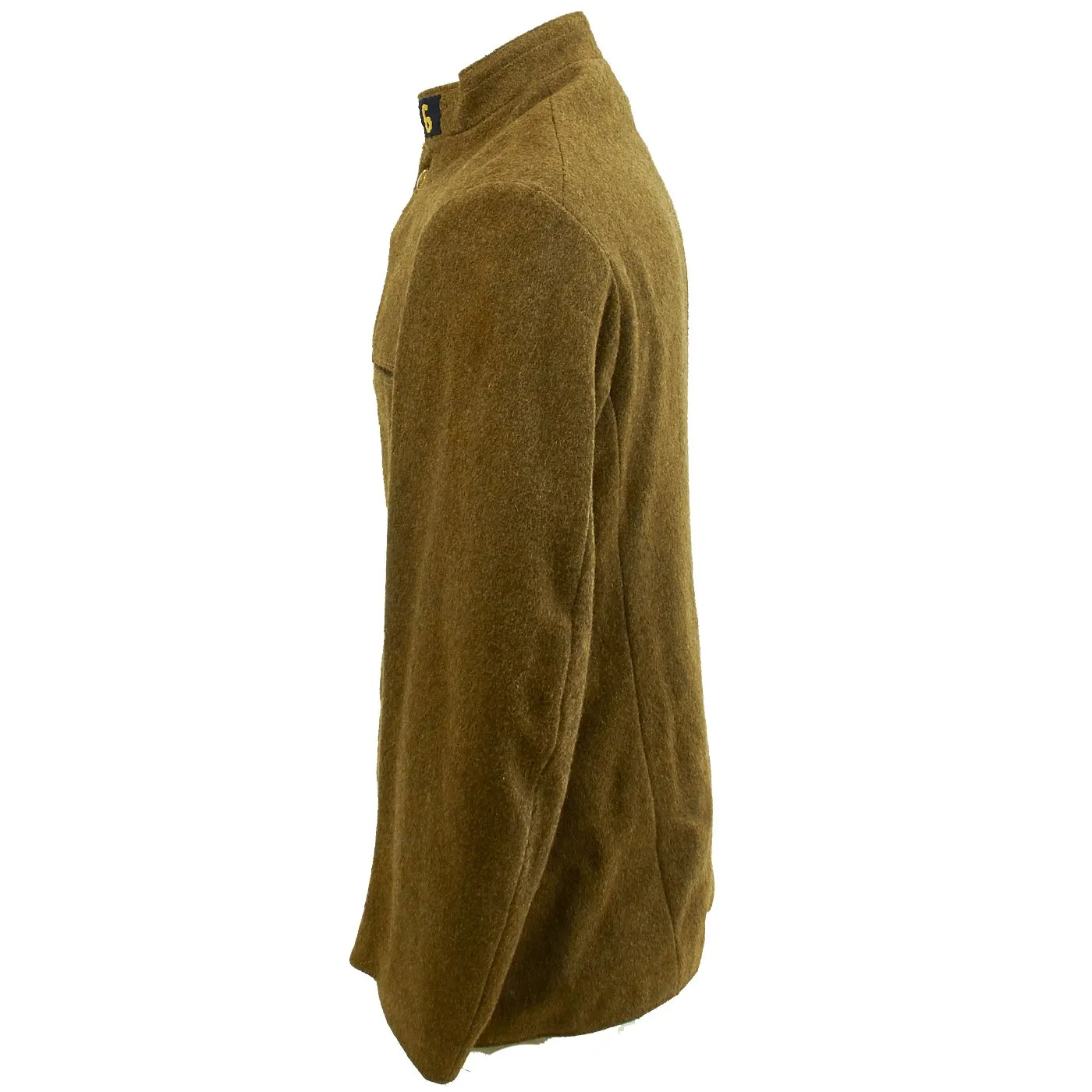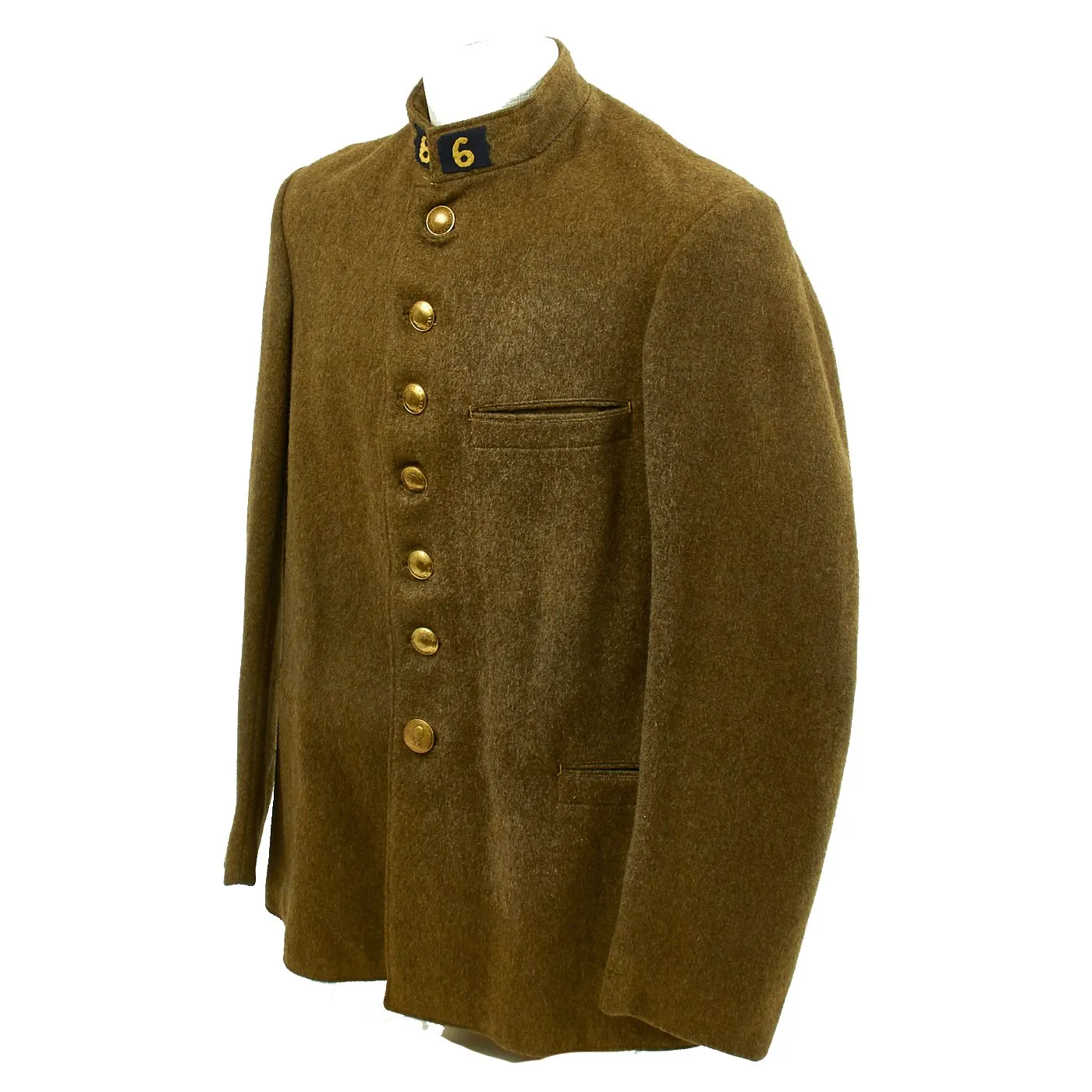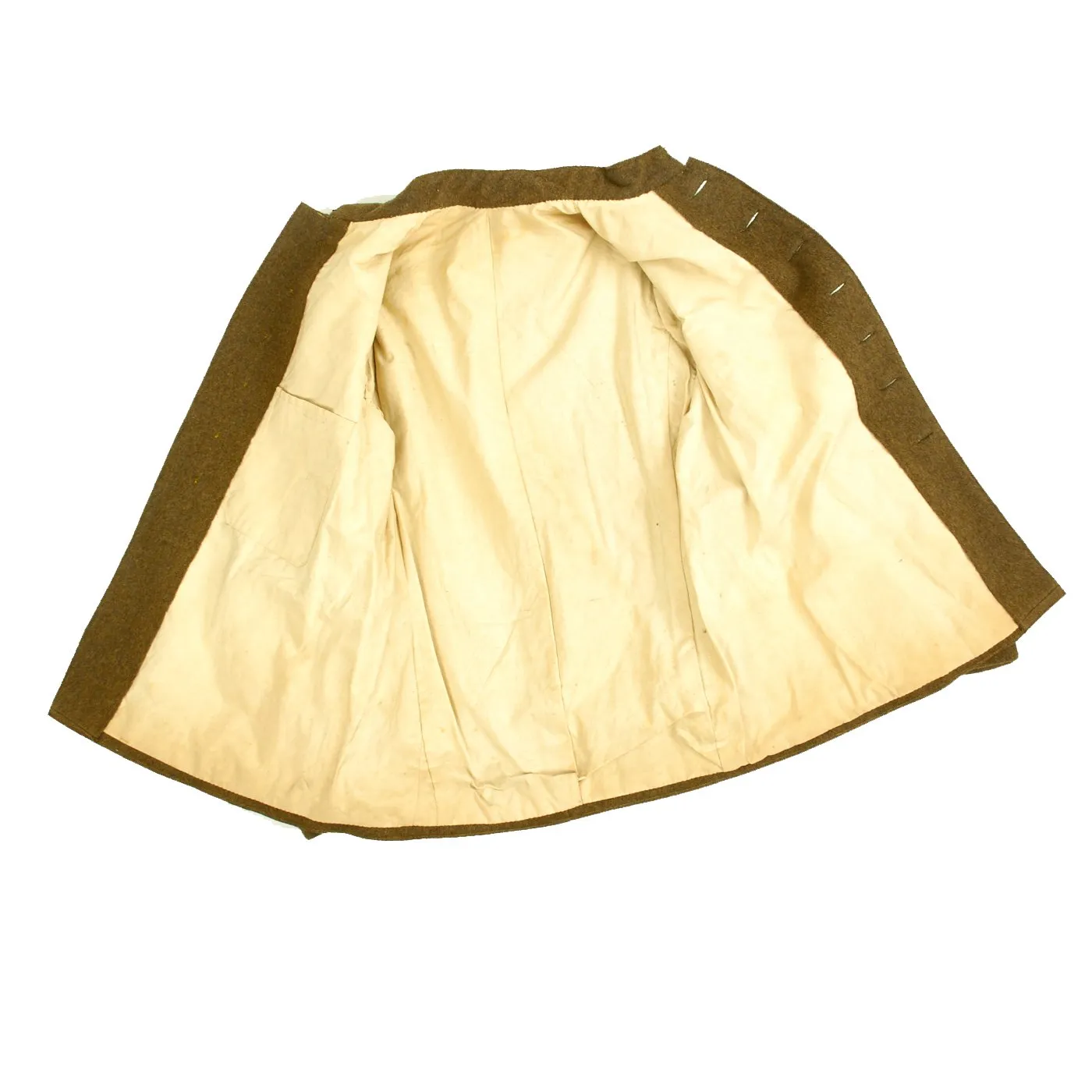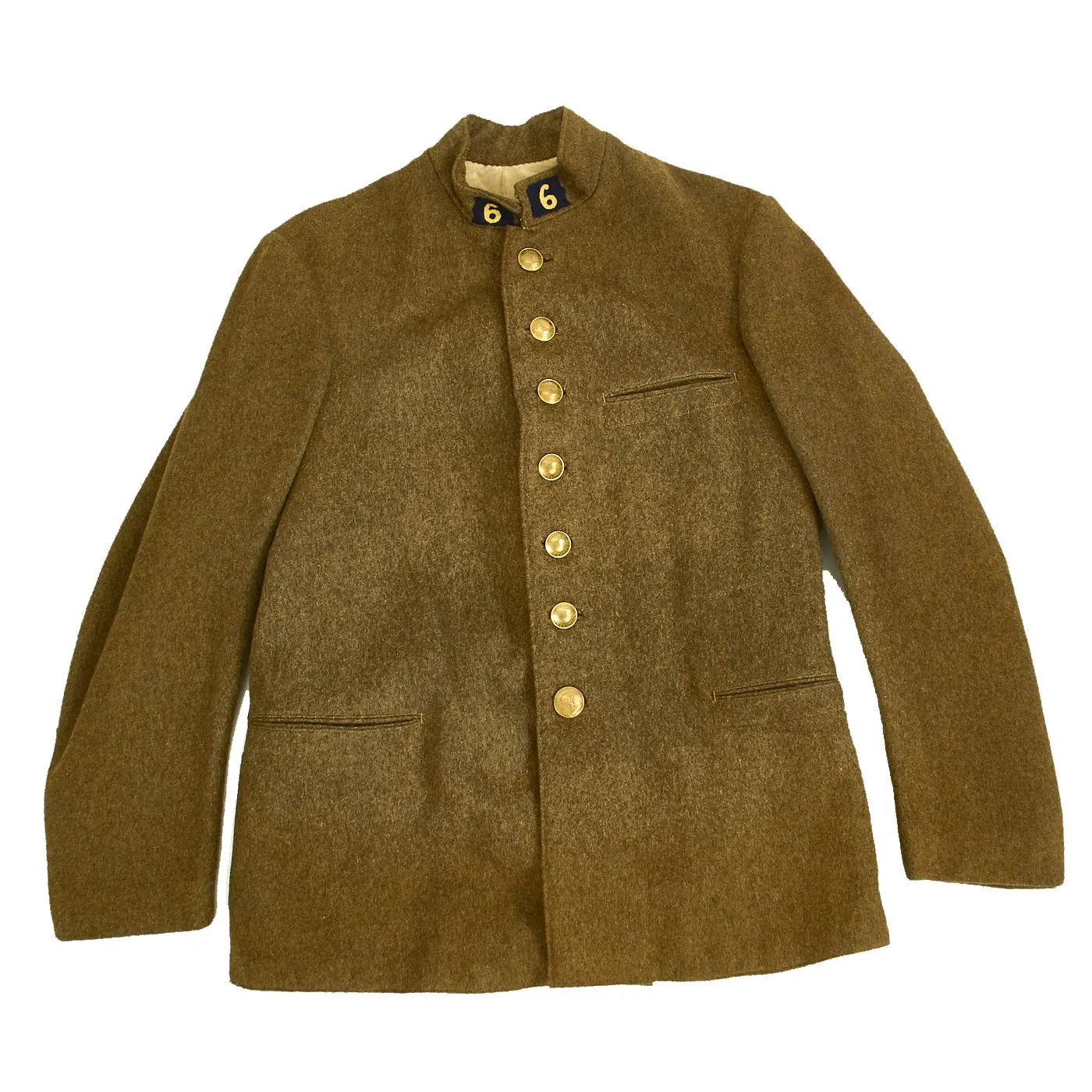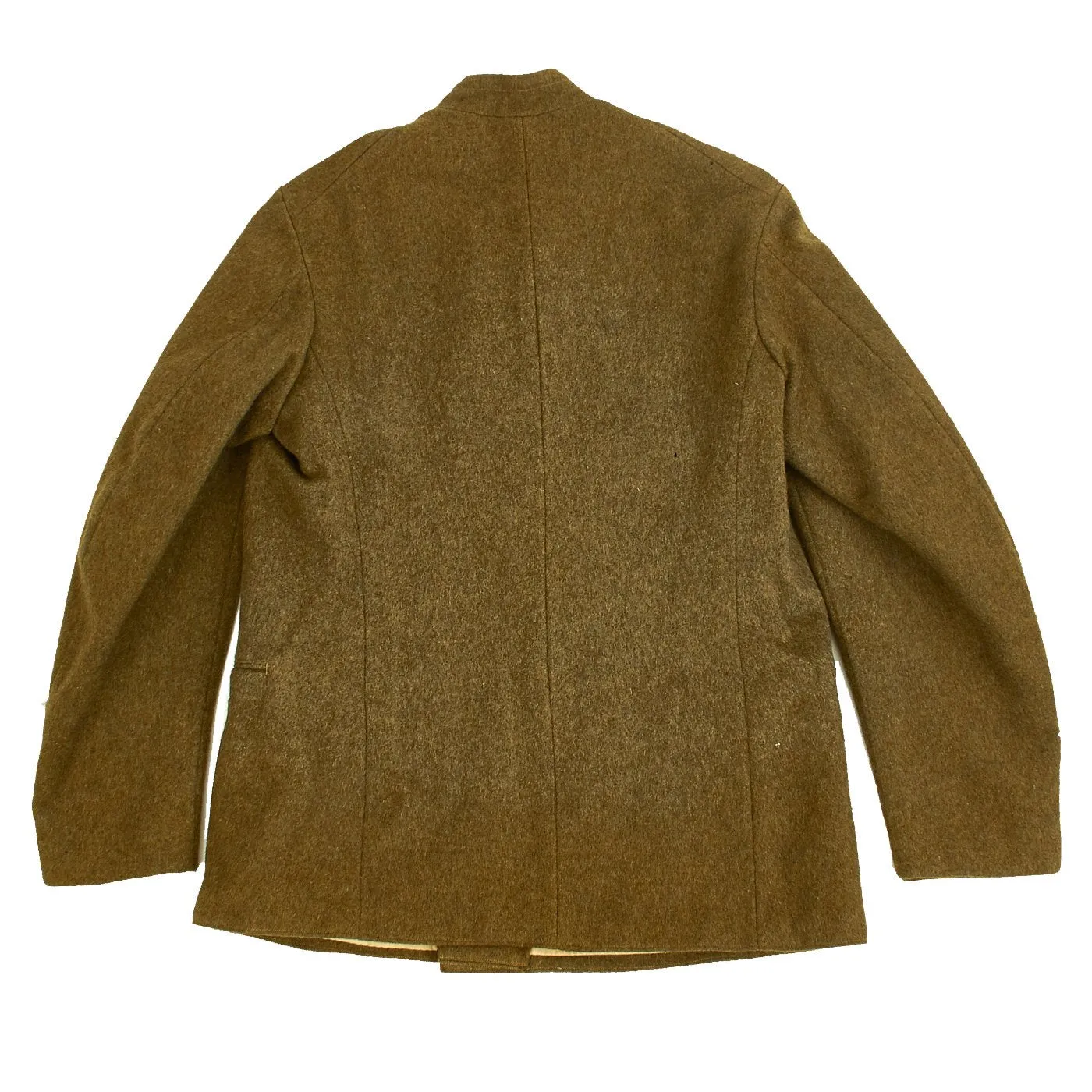Original Item: Only One Available. This is a heavy wool tunic with French Foreign Legion - Legion Etrangere hollow back buttons. Interior is lined with heavy cotton linen. Number 6 collar tabs in yellow with dark blue bases, unknown origin. Dating from before or during the World War Two era. Most likely colonial North African issue.
Approximate Measurements:
Collar to shoulder: 9”
Shoulder to sleeve: 25”
Shoulder to shoulder: 18”
Chest width: 19”
Waist width: 18”
Hip width: 22”
Front length: 28"
French Foreign Legion in WWII:
Influx of recruits
The Foreign Legion was heavily involved in World War II, playing a large role in the Middle East and the North African campaign. The 6th Foreign Infantry Regiment was established by consolidating battalions stationed in Syria into a single battalion on October 15, 1939. Around the beginning of the war the primary training camp of the Legion was located at Saïda, however by October 1939, another training camp was established at Bacarès near the Spanish border. The facility at Bacarès was re-purposed as training facility from an internment camp for Spanish refugees from the Spanish Civil War. Foreign Legion Forces being trained at these locations were provided inadequate arms and equipment – mostly surplus World War I-era equipment – which demonstrates the degree of low regard which the Foreign Legion by French military authorities. The 13th Foreign Legion Demi-Brigade was raised in February 1940 for the purpose of deploying to Finland.[ By February 1940, over 84,000 foreigners had volunteered to serve France which led to great organizational difficulties for the French Foreign Legion. During this time a large number of recruits in the Foreign Legion were Spanish Republicans and East European Jews, many of whom held their personal ideologies very close to their hearts causing difficulty in their assimilation into the Foreign Legion. Not only did political refugees from Spain and East Europe prove difficult to assimilate into the Legion, but so did many of the reservist, former Legionnaires who returned to the Legion when called up as they were no longer young men and had families to look after. Most of Foreign Legion remained in training until the Germans launched their offensive against France on May 10, 1940.
Battle of France
Six units of the French Foreign Legion participated in the Battle of France: the 11th Foreign Infantry Regiment, the 12th Foreign Infantry Regiment, the Reconnaissance Group of the 97th Infantry Division, the 21st Marching Regiment of Foreign Volunteers (21st RMVE), the 22nd Marching Regiment of Foreign Volunteers, and the 23rd Marching Regiment of Foreign Volunteers. The 11th REI defended the northern Inor Wood near Verdun from the German offensive early on in the battle until June 11, 1940 when the regiment began a fighting retreat to the south. By June 18, the 11th REI had lost three-fourths of its strength and the regiment withdrew to the south near Toul. The 12th REI was redeployed from its training center in Valbonne on May 11 to defend the Soissons where it arrived on May 24 and eventually began to fortify their positions. The 12 REI first experienced a form of combat for which they were unprepared when on June 5, the town of Soissons was the subject of German strafing from Stukas. By June 8, the 12th REI, in danger of being encircled, received orders to retreat to the south, however the orders did not come soon enough and parts of the 12th REI were surrounded at Soissons; the rest of the 12th REI made their way to Limoges by the signing of Second Armistice at Compiègne on June 25, 1940. By the surrender of France the 12th REI had lost 2,500 of its number. The 21st Marching Regiment of Foreign Volunteers was deployed to the Maginot Line when the German offensive began, but was shifted to the north of Verdun by the end of May. The 21st RMVE took heavy losses during an engagement with the Germans on June 8 and 9; the 21st RMVE joined the rest of the French Army in that sector in retreat when the order to retreat was given. At the time of the armistice the 21st RMVE was at Nancy where it was disarmed by German forces. The 22nd Marching Regiment of the Foreign Volunteers left its training depot at Bacarès on May 6 when it was deployed around Alsace. The German offensive forced the 22nd RMVE to be quickly redeployed on the Somme near the village of Marchélepot where it fought a defensive action from May 22 to May 26. On June 5, the 22nd RMVE was preparing to counterattack the Germans at Villers-Carbonnel alongside the 112th Infantry Division when it came under a heavy preemptive attack launched by German forces in the area. The French Forces were able to initially repulse the attack, but later succumbed to the German onslaught; the force of the Foreign Legion acquitted themselves admirably in that engagement.
The Narvik Expedition
In January 1940, French high command made the decision to deploy a brigade to assist Finland in its defense against the forces of the Soviet Union in the Winter War. This new force, drawn from the ranks of the Foreign Legion's North African regiments, began the process of formation in February 1940 and was complete by March 27 when it took its new name as the 13th Demi-Brigade of the Foreign Legion. Despite the efficient establishment of the 13th Demi-Brigade of the Foreign Legion, the planned deployment of the unit was set back by the capitulation of Finland on March 12; absent the option to deploy to Finland, the Allies elected to deploy the expeditionary force they were forming for Finland to Norway. The 13th Demi-Brigade trained in Larzac until it shipped out to Scotland where it would deploy with a force assembled by the rest of the Allies. The expeditionary force deployed to northern Norway where it planned to engage the German forces holding Narvik.
On May 13, 1940, the 13th Demi-Brigade participated in an amphibious assault on the shores of the Herjangs Fjord near Narvik. The amphibious assault was conducted on torpedo boats under strafing by German fighters. Once on the shore, Foreign Legion forces moved to secure the high ground around the landing zone.
The North African Campaign
The 13th Demi-Brigade was deployed in the Battle of Bir Hakeim. Part of the Legion was loyal to the Free French movement, yet another part was loyal to the Vichy government. A battle in Syria saw two opposing sides fight against each other in a short engagement, and later on the Vichy Legion joined its Free French brethren.




